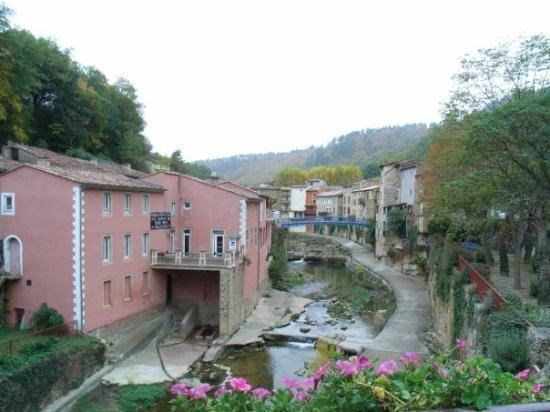Time zone CET (UTC+1) Area 18.77 km² Local time Monday 11:13 PM | Region Occitanie Canton Couiza INSEE/Postal code 11310 /11190 Population 171 (2008) | |
 | ||
Weather 9°C, Wind SE at 13 km/h, 79% Humidity | ||
Rennes-les-Bains or Les Banhs de Rènnas is a commune in the Aude department in southern France.
Contents
Map of 11190 Rennes-les-Bains, France
Bathers have enjoyed the natural hot spring waters for thousands of years - they are still used today as a cure for rheumatism and certain skin problems. Today, it is a modern thermal spa with the latest equipment. Due to a microbe found in the piping of the old baths they have been closed and a new hospital built which gets its water from another source. Due to its enormous popularity the 'Bains Forts', an old 'lavoir' where young people have bathed for the last 40 years, have been cemented in and closed indefinitely. This event has led some to rename Rennes-les-Bains, Rennes-sans-Bains.
Geography
Rennes-les-Bains is located in the valley of the River Sals, 48 km (30 mi) from Carcassonne, 20 km (12 mi) from Limoux, and 3 km (1.9 mi) from Rennes-le-Château.
History
The origins of Rennes-les-Bains go back to Antiquity. Archaeological artifacts indicate that the spa was at one time popular with the Roman colony in Colonia Narbo Martius (Narbonne).
Traditionally the serving doctor of the village is also the historian. As of 2007 the current doctor is Dr André Authier who has written one book and co-authored another on "thermalisme".
Miscellaneous
Rennes-les-Bains is known for another reason, however: it is mentioned numerous times in many books about Rennes-le-Chateau, famous now also because of Dan Brown's novel The Da Vinci Code. Subsequently, the author Kate Mosse set the larger part of her 2007 novel Sepulchre in the immediate vicinity.
Abbé Henri Boudet was the parish priest of Rennes-les-Bains at the same time that Bérenger Saunière was the incumbent of Rennes-le-Château. Boudet's strange book, La vraie langue celtique et le cromleck de Rennes-les-Bains (1886) argued that all languages were derived from the English tongue whereby the Abbé tried to establish his theory through the use of puns.
In 1832 a book by Auguste de Labouïsse-Rochefort entitled Voyages à Rennes-les-Bains first referred to a treasure located at Mont Blanchefort, whereby a story was told about a wizard who nearly succeeded in taking the purse-strings of the Devil, but failed because the local villagers did not help him at the crucial moment - Auguste de Labouïsse-Rochefort had married a daughter of a millionaire that had lost his fortune.
In Les Amours, A Éléonore, recueil D’élégies divisé en Trois Livres (1817), Auguste de Labouïsse-Rochefort had the motto "Et in Arcadia ego" placed on its title page; this was a reference to the Academy of Arcadia that was formed in Italy in 1690 - Labouïsse-Rochefort later became a member of the Academy in 1832.
Since July 1985 the village has been twinned with the city of Rennes in Brittany.
